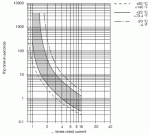As Bennett just suggested, I had told you to long term limit the B&C 18TBW100-4 to about half it's 1500 watt 6 dB crest factor A.E.S rating (don't know where you are getting 1200),"RMS" implies sine waves, a 3 dB crest factor, or 750 watts. The Keystone has a minimum impedance near the DCR of the speaker (3.2 ohms) at around 37 Hz (IIRC) so 50 volts results in about 781 watts at a frequency likely to contain heavy droning bass in EDM which may have as little as 3 dB crest factor. 750 watts at 3 dB crest factor is the equivalent average power of 1500 watts at 6 dB crest factor, or 3000 watts at 12 dB crest factor.
Long term limiting the BMS 4594 (or 4595) mid/high driver to 115 watts will not protect the mid driver rated for 150w AES (75 watts sine or "RMS") or the HF driver rated for 80 watts AES (40 watts sine or "RMS", just a bit over half the mid driver's rating).
That said, I have not (yet) heard reports of music with less than 6 dB crest factor in the HF (the crest factor of Metallica's latest recording...) , but if you work in hot, dry locations, the amount of HF boost required to compensate for HF air absorption (10 dB or more above 10kHz) could fry the HF diaphragm if set for more than 40 watts long term.
When using two differently rated drivers on one amp, the only way to protect both is using frequency dependent limiting.
Art


